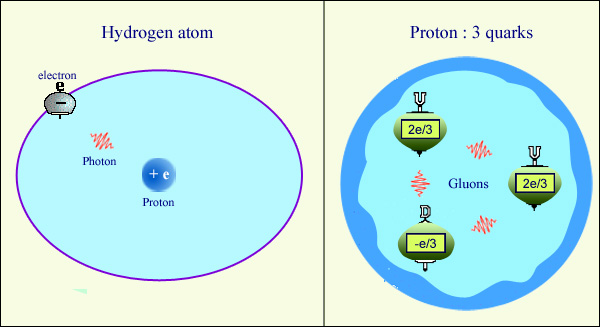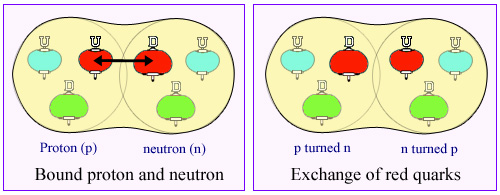How quarks interact within nuclei …
To describe radioactivity and nuclear reactions such as fission, we can content ourselves with the image of nuclei composed of protons and neutrons. It is now known that protons and neutrons are composed of elementary corpuscles held together by a very intense attraction, the quarks. The existence of quarks has been confirmed by numerous experiments, but it has not been possible to extract them individually from nuclear matter, which gives an idea of the intensity of the attraction that binds them together.
What is the origin of the hidden attraction inside nucleons and nuclei?

Hydrogen atom and proton : photons and gluons
Parallel between the forces at work in a hydrogen atom and a proton. The attraction that causes the electron in the atom to turn around the nucleus (reduced to a proton) results from the exchange of multiple photons between the electron and the nucleus, whose electrical charges are opposite. Inside the proton itself, the three quarks that are its constituents exchange waves called gluons, which are quite similar to photons. Quarks carry special charges that allow them to exchange these gluons.
© IN2P3
The quarks carry both an electric charge and a strong charge. This charge is very special. A quark can exist in three states. To distinguish them, the physicists attributed to them a color, of course fictitious. For example, a quark-up will exist with three variants, a red quark-up, a blue quark-up, a green quark-up. Likewise a quark down. The strong charges borne by the red, blue and green variants have the same intensity. In antimatter, antiquarks color charges are called anti-red, anti-blue and anti-green.
In a proton or neutron, the 3 quarks have a different “color”. Because of this distinction, two quarks up (or two quarks down) are no longer completely identical. If they were identical, one of the fundamental principles of quantum mechanics, the Pauli exclusion principle , would forbid them to be in the same place with the same state of rotation, and thus a proton or neutron would not exist. On the other hand, if one is red, the other green or blue, they can coexist in the tiny proton or neutron volume.
Each kind of elementary interaction, electromagnetic or weak, is associated with a charge and a messenger wave exchanged between the particles carrying this charge. In the case of electromagnetic interaction, the waves exchanged between the electrons and the nucleus are familiar, photons. In the case of strong interactions, messenger waves are called gluons. Similar in some respects to photons, they are much less familiar, as they remain confined within the nuclear material like quarks. As their name suggests, their role is to glue quarks together and make compact protons, neutrons and nuclei.

Configuration of quarks “colour” charges inside a proton
Physicists represent the 3 states of strong charges of the quarks of a proton, by colors, for example red, blue and green. In a proton (or neutron) which has 3 quarks, the 3 colors are present. This gives 6 color configurations for the 3 quarks of a proton. The quarks constantly exchange gluons. These exchanges of gluons – not represented in the figure – interchange the colors of the quarks. As a result, a proton or neutron passes continuously from one of these 6 configurations to the other. Globally, the nucleons and more generally the nuclei appear neutral, without defined color.
© IN2P3
Inside a proton or a neutron, the three colors are equally represented. Using again the vocabulary of physicists, the sum of the strong quarks charges shows a nucleon without a defined color, neutral, white in some way. Generally speaking, only assemblies whose global color is neutral, the white assemblies, benefit from attractive forces which allow to observe them. This is the case for nucleons and nuclei, and if we add antimatter, mesons (assemblies of a quark and an antiquark) and antinucleons (assemblies of 3 antiquarks).
A nucleon is not composed only of its three quarks, known as valence quarks, but also of the gluons that accompany them. What also differentiates the gluons from the photons of the electromagnetic forces is that they possess a strong charge but no electric charge, whereas the photons do not possess either. According to the vocabulary of physicists, gluons are themselves “colored.”
Let us consider the case of a gluon exchanged between a red quark and a green quark. When it is emitted the red quark turns green. When it is received by the green quark, the latter turns red. The color charge of this gluon appears composite: it could be called red-antigreen. There are 8 possible charges of colors for the gluons.
Valence quarks and gluons are not the only constituents of protons and neutrons. In addition, there are further temporary quarks and antiquarks. In effect, a gluon has the possibility of coupling with a quark and an antiquark, and to materialize during very short times in these particles. For example, a red-antigreen gluon would temporarily give rise to a red up quark and a green up antiquark, which would recombine later (NB: This coupling is similar to that of a photon with an electron and positron pair).
Overall, valence quarks, gluons, transient quark and antiquark pairs, make a very complex object of a simple proton or neutron, long considered as an elementary brick of matter.

Protons and neutrons assemble in nuclei
The simplest nucleus after hydrogen is the deuterium which forms when a proton enters in contact with a neutron (only the valence quarks have been represented in the figure). Both nucleons are subjected to attractive forces, the three colors being present equally in them. Quarks and gluons do not remain motionless. In this example, the red up quark of the initial proton passes into the neutron on the right, to be replaced by its red down quark. The exchange swaps proton and neutron. In the course of many exchanges, quarks and gluons belong to the nucleus rather than to a particular nucleon.
© IN2P3
Busy with their exchanges, quarks and gluons remain confined inside a tiny sphere of about a fermi (millionth of a billionth of a meter) of radius. The situation changes when the tiny spheres of several nucleons come into contact. Exchange of quarks and gluons takes place between these closed confined spheres which would assemble to form a nucleus. The community of quarks and gluons of this assembly remain neutral of color. As a result, quarks and gluons are subjected to a global attraction that welds the nucleus.
Inside a nucleus quarks and gluons blend into a community. The boundaries between nucleons lose their meaning. The nucleus is more like a confederal Europe than a Europe of Nations. The balance between the up and down quarks varies with the size of the nuclei, which goes up to the size of the heavy nuclei. Can there be a Brexit? When excess energy permits, groups of quarks can leave the nucleus. But they must exit by 3 or multiples of 3 to be neutral of color, to form stable states: for example the 3 quarks constituting a neutron, the 12 quarks of an alpha particle. The irruption of the 3 quarks of a neutron triggers the fission of the community of the 705 quarks of a nucleus of uranium-235 into two less populated communities of fission fragments.
Other articles on the subject « The atomic nucleus »
The proton
The charged constituent of the nucleus The nucleus of the hydrogen atom consists of one solitary [...]
The Neutron
The neutral partner of the proton The neutron is, along with the proton, one of the two constitue[...]
Isotopes
Nuclear variants of a given atom … Free of all electric charge and present only in the nucleus, n[...]
Nucleus Energy Levels
Analogies with the atomic energy levels … At first glance, nuclei seem to be very different[...]
Quarks and leptons
The fundamental constituents of matter On the most elementary scale, the world around us is made [...]
Matter and Antimatter
Nature loves symmetry. However, one can not dream of a matter less symmetrical than the matter wh[...]